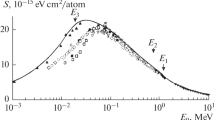An algorithm is proposed for calculating stopping loss functions in targets in accelerators which accelerate hydrogen isotope nuclei for generating neutrons. The algorithm is based on interpolation matching of empirical formulas for determining stopping losses at low energies with the Bethe–Bloch relation, which describes the stopping process exactly at medium and high energies. Examples of a calculation of the stopping loss functions for hydrogen isotope nuclei and the dependence of the kinetic energy on the penetration depth in the target for hydrogen–metal compounds, which can be used as neutron-forming targets, are presented.
Similar content being viewed by others
References
T. Gozani, “Advances in accelerator based explosives detection systems,” Nucl. Instrum. Methods in Phys. Res. B, 79, 601–604 (1993).
V. M. Bystritskii, M. I. Zamyatin, V. G. Kadyshevskii, et al., “JINR study of the nuclear-physical methods of identifying hidden substances,” in: Int. Sci.-Techn. Conf. on Portable Neutron Generators and Technologies Based on Them, VNIIA, Moscow (2005), pp. 306–319.
B. Yu. Bogdanovich, M. V. Kirillov-Ugryumov, A. E. Shikanov, et al., “Prospects of using linear electron and hydrogen-nuclide accelerators in solving problems of ore geophysics,” in: Rep. Int. Sci.-Appl. Conf. on Nuclear-Geophysical Field, Well, and Analytical Methods in Solving the Problems of Exploration, Surveying, and Development of Deposits of Solid Ores, VNIIGeosistem, Moscow (2009), pp. 231–235.
V. T. Tustanovskii, Neutron Generators and Monitoring of Technological Processes, Atomizdat, Moscow (1980).
B. Yu. Bogdanovich, V. V. Kapin, A. V. Nesterovich, and A. E. Shikanov, “Prospects for using a neutron generator based on small linear resonance deuteron and proton accelerator for remote detection of hidden substances,” in: Int. Sci.-Techn. Conf. on Portable Neutron Generators and Technologies Based on Them, VNIIA, Moscow (2005), pp. 369–371.
B. Yu. Bogdanovich, A. V. Nesterovich, and A. E. Shikanov, RF Patent No. 2356036, “Method of detecting and identifying hidden dangerous objects,” July 27, 2007, Byull. Izobr. Polez. Modeli, No. 14, 1012 (2009).
A. A. Klyuchnikov, N. F. Kolomiets, G. Ya. Minchuk, and V. N. Chervinskii, Principles of the Construction and Application of Tritium–Metal Structures, Naukova Dumka, Kiev (1992).
V. I. Boiko, V. A. Skvortsov, V. E. Fortov, and I. V. Shamanin, Interaction of Pulsed Charged Particle Beams with Matter, Fizmatlit, Moscow (2003).
K. Leiman, Interaction of Radiation with Solids and Formation of Elementary Defects, Atomizdat, Moscow (1979).
Yu. V. Gott, Interaction of Particles with Matter in Plasma Research, Atomizdat, Moscow (1978).
N. G. Gusev, V. A. Klimanov, V. P. Mashkovich, and A. P. Suvorov, Protection from Ionizing Radiations. Vol. 1. Physical Principles of Radiological Protection, Energoatomizdat, Moscow (1989).
Author information
Authors and Affiliations
Additional information
Translated from Atomnaya Énergiya, Vol. 109, No. 5, pp. 293–298, November, 2010.
Rights and permissions
About this article
Cite this article
Bogdanovich, B.Y., Nesterovich, A.V. & Shikanov, A.E. Particulars of hydrogen isotope stopping in accelerators for neutron generation. At Energy 109, 362–368 (2011). https://doi.org/10.1007/s10512-011-9369-5
Received:
Published:
Issue Date:
DOI: https://doi.org/10.1007/s10512-011-9369-5




